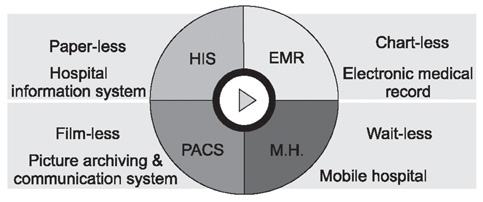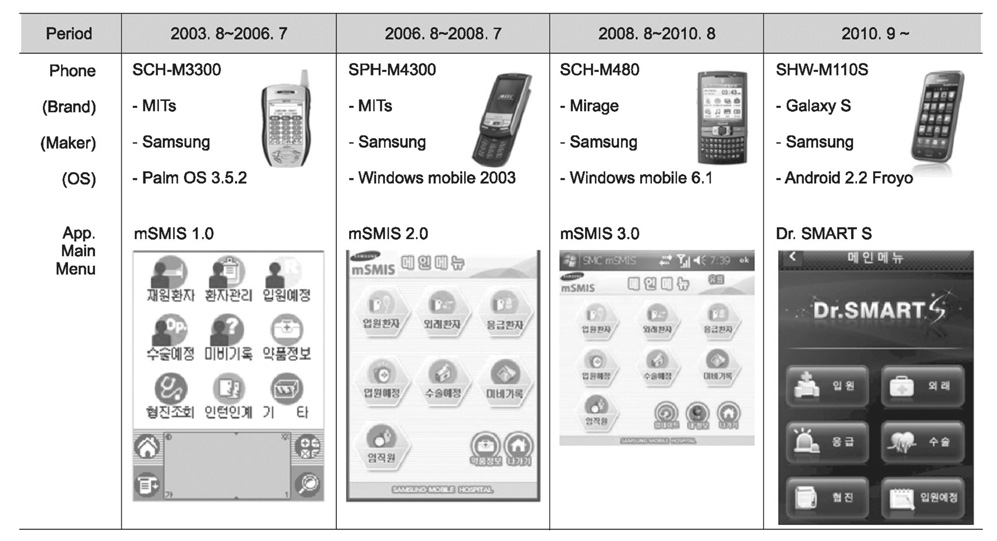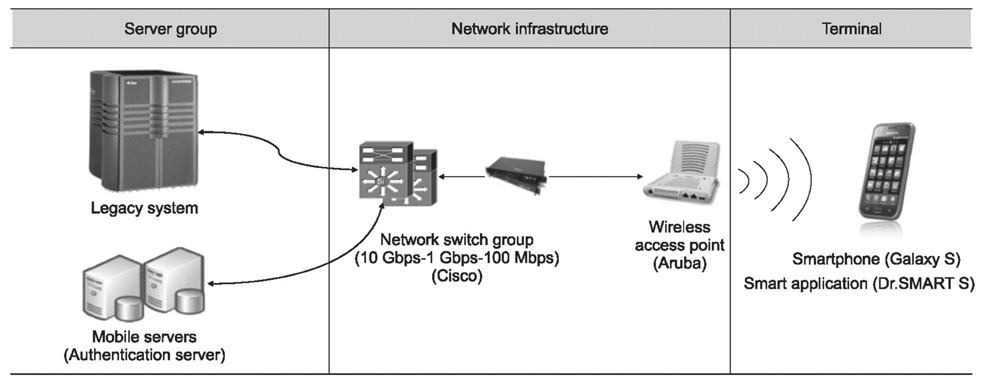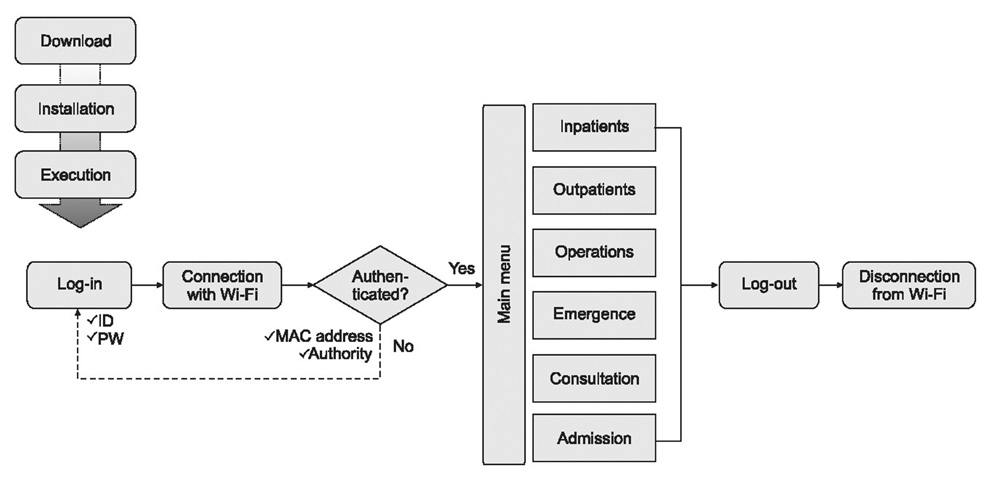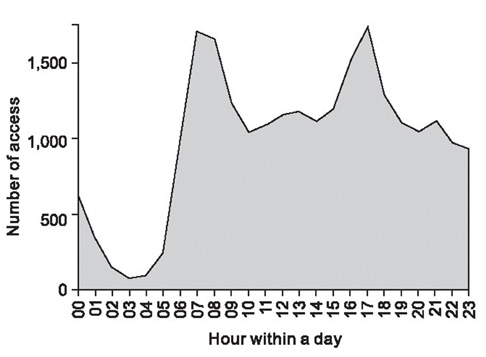The Uses of the Smartphone for Doctors: An Empirical Study from Samsung Medical Center
- Affiliations
-
- 1Health Information Center, Samsung Medical Center, Seoul, Korea. pl.rhee@samsung.com
- 2Department of Industrial Information Systems Engineering, Soongsil University, Seoul, Korea.
- 3Korea Regional Studies Institute, Seoul National University, Seoul, Korea.
- 4Department of Medicine, Sungkyunkwan University School of Medicine, Seoul, Korea.
- KMID: 1447790
- DOI: http://doi.org/10.4258/hir.2011.17.2.131
Abstract
OBJECTIVES
In healthcare, mobile computing made possible by smartphones is becoming an important tool among healthcare professionals. However, currently there is very little research into the effectiveness of such applications of technology. This study aims to present a framework for a smartphone application to give doctors mobile access to patient information, then review the consequences of its use and discuss its future direction.
METHODS
Since 2003 when Samsung Medical Center introduced its first mobile application, a need to develop a new application targeting the latest smartphone technology was identified. To that end, an application named Dr. SMART S was officially launched on December 22nd, 2010.
RESULTS
We analyzed the usage data of the application for a month until April 25th, 2011. On average, 170 doctors (13% of the entire body of doctors) logged on 2.4 times per day and that number keeps growing. The number was uniformly distributed across all working hours, with exceptions of heavy accesses around 6-8 AM and 4-6 PM when doctors do their regular rounds to see the patients. The most commonly accessed content was inpatient information, this constituted 78.6% of all accesses, within this 50% was to accesses lab results.
CONCLUSIONS
Looking at the usage data, we can see the use of Dr. SMART S by doctors is growing in sync with the popularity of smartphones. Since u-Health seem an inevitable future trend, a more rigorous study needs to be conducted on how such mobile applications as Dr. SMART S affect the quality of care and patient safety to derive directions for further improvements.
MeSH Terms
Figure
Cited by 4 articles
-
Ubiquitous Health in Korea: Progress, Barriers, and Prospects
Yountae Lee, Hyejung Chang
Healthc Inform Res. 2012;18(4):242-251. doi: 10.4258/hir.2012.18.4.242.Development of Mobile Electronic Health Records Application in a Secondary General Hospital in Korea
Wookjin Choi, Min Ah Park, Eunseok Hong, Sunhyu Kim, Ryeok Ahn, Jungseok Hong, Seungyeol Song, Tak Kim, Jeongkeun Kim, Seongwoon Yeo
Healthc Inform Res. 2013;19(4):307-313. doi: 10.4258/hir.2013.19.4.307.Going Abroad of Korean Health Information Systems
Young Moon Chae
Healthc Inform Res. 2014;20(3):161-162. doi: 10.4258/hir.2014.20.3.161.Technology Acceptance and Adoption of Innovative Smartphone Uses among Hospital Employees
Byung Chan Moon, Hyejung Chang
Healthc Inform Res. 2014;20(4):304-312. doi: 10.4258/hir.2014.20.4.304.
Reference
-
1. Lu YC, Xiao Y, Sears A, Jacko JA. A review and a framework of handheld computer adoption in healthcare. Int J Med Inform. 2005. 74:409–422.
Article2. Lee MH, Kim J, Jee SH, Yoo SK. Integrated solution for physical activity monitoring based on mobile phone and PC. Healthc Inform Res. 2011. 17:76–86.
Article3. Dala-Ali BM, Lloyd MA, Al-Abed Y. The uses of the iPhone for surgeons. Surgeon. 2011. 9:44–48.
Article4. Choi JS, Lee WB. Economic analysis on the introduction of hospital mobile zone service: a case study of S hospital's communication expenses. Telecommun Rev. 2010. 20:683–695.5. Doylestown Hospital [Internet]. Apple Inc. c2011. cited at 2011 Apr 19. Cupertino, CA: Apple Inc.;Available from: http://www.apple.com/iphone/business/profiles/doylestown/.6. Mount Sinai Hospital [Internet]. Apple Inc. c2011. cited at 2011 Apr 19. Cupertino, CA: Apple Inc.;Available from: http://www.apple.com/iphone/business/profiles/mt-sinai/.7. Yu P, Wu MX, Yu H, Xiao GC. The challenges for the adoption of M-health. Proceedings of IEEE International Conference on Service Operations and Logistics and Informatics (SOLI). 2006. Shanghai, China: IEEE;181–186.
Article8. Choi JS, Kim DS. A case study on the implementation of a real-time patient monitoring system based on wireless network. Ind Eng Interfaces. 2010. 23:246–256.9. Nolan T. A smarter way to practise. BMJ. 2011. 342:d1124.
Article10. Ahn ME, Choi GH. A developmental process of telemedicine, e-health & u-health. J Korean Med Assoc. 2009. 52:1131–1140.
Article
- Full Text Links
- Actions
-
Cited
- CITED
-
- Close
- Share
- Similar articles
-
- The Relationship Between Types of Smartphone Use, Digital Literacy, and Smartphone Addiction in the Elderly
- Smartphone Use Patterns of Smartphone-dependent Children
- Excessive smartphone use, smartphone dependency and body image distortion in Korean adolescents
- Relationships between Smartphone Usage, Sleep Patterns and Nursing Students' Learning Engagement
- Reliability and Validity of Angle of Trunk Rotation Measurement Using Smartphone and 3D Printing Technology in Scoliosis

